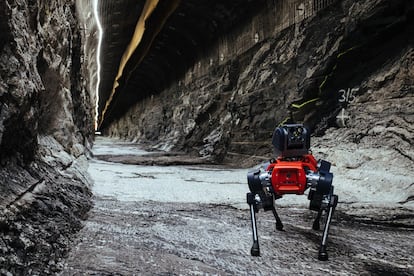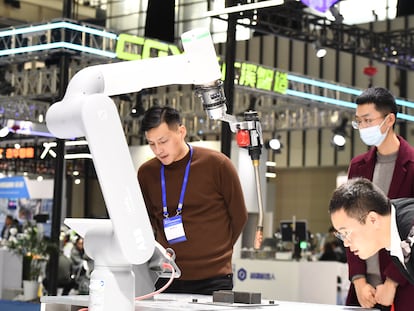Meet ANYmal, the four-legged robot that could substitute humans in dangerous environments
The all-terrain machine can move through difficult landscapes, analyze its surroundings and tackle real-world challenges autonomously

It’s called ANYmal and, true to its name, it functions like an animal. This robot, about the size of a dog, boasts impressive autonomy. Locomotion — the ability to move from one place to another — is one of the most challenging skills for machines to master. Typically, they learn to walk in controlled environments to avoid accidents, but researchers at ETH Zurich University in Switzerland have trained ANYmal to face real-world challenges. The latest version can climb stairs, walk on narrow beams, and navigate natural environments with rough and slippery surfaces. ANYmal’s inventors recently described their progress in an article for Science Robotics magazine.
ANYmal was designed to navigate through obstacle-filled courses on 76,000 square meters of specially designed terrain. The challenge required precise steps and versatile mobility skills to avoid falls. “We recreated challenging environments similar to those at natural disaster sites, where debris could crumble when stepped on, and at construction sites with oily and slippery surfaces,” said Fabian Jenelten, a professor of robotics at ETH Zurich and lead author of the study.
The robot can operate independently, making decisions and adapting without constant human intervention. Equipped with cameras, sensors, gyroscopes and Lidar (light detection and ranging sensors), it can perceive its surroundings, measure distances, create maps and detect gas leaks. It can also carry payloads of up to 10 kilos (22 pounds).
Quadruped robots learn to walk in two ways: through deep learning methods for handling different terrains or traditional methods for more precise movements. This can lead to a trade-off between versatility and accuracy, causing problems for robots in the real world. Jenelten’s team tackled this by combining the precision of traditional methods with the versatility offered by deep learning. As a result, ANYmal was able to achieve proprioception (the sense that lets us perceive the location, movement and action of our body parts) similar to humans and animals. “In our work, we aim to combine both aspects, enabling quadruped robots to conquer new environments relevant for future applications,” said Jenelten.
ANYmal isn’t unique. Its distant relative Spot, made by Boston Dynamics, is a quadruped robot with very similar capabilities. Ford has deployed some in its factories to monitor and prevent potential breakdowns on assembly lines. Sword Defense Systems has equipped robots with a precision rifle for long-distance targeting and thermal vision for night operations. Other Spots have been taken to New Zealand to work as shepherds.
The creators of ANYmal anticipate that, in a few years, the robots will actively aid humans in rescue missions after disasters such as earthquakes and explosions. By utilizing Lidar, they will map out areas to predict landslides and unsafe routes. Looking to the future, Jenlets said: “These robots have great potential to substitute humans in dangerous and potentially lethal environments.”
Robots: not replacements but assistants
Rodolfo Haber, director of Spain’s CSIC Center for Automation and Robotics, believes these robots “will be more like assistants and companions rather than complete replacements for humans.” In large cities, they can assist people with hearing, visual and other disabilities. The machines will not necessarily replace workers. “A robot can help a construction worker reach the age of 60 in a stronger physical condition,” said Haber.
Robot locomotion using legs was popular in the past, with researchers in Spain creating six-legged machines to detect explosive mines. Although many quadruped robot projects were abandoned, Haber believes that advances in artificial intelligence can enhance newer models, leading to renewed interest from various industries and significant market and social impacts.
ANYmal’s inventors and Rodolfo Haber view the advancements in locomotion achieved by ANYmal as crucial for the future of legged robots. With this progress and the ongoing evolution of technology and artificial intelligence, it’s plausible that in a few years, four-legged robots assisting people will be a common sight on the streets.
Sign up for our weekly newsletter to get more English-language news coverage from EL PAÍS USA Edition
Tu suscripción se está usando en otro dispositivo
¿Quieres añadir otro usuario a tu suscripción?
Si continúas leyendo en este dispositivo, no se podrá leer en el otro.
FlechaTu suscripción se está usando en otro dispositivo y solo puedes acceder a EL PAÍS desde un dispositivo a la vez.
Si quieres compartir tu cuenta, cambia tu suscripción a la modalidad Premium, así podrás añadir otro usuario. Cada uno accederá con su propia cuenta de email, lo que os permitirá personalizar vuestra experiencia en EL PAÍS.
¿Tienes una suscripción de empresa? Accede aquí para contratar más cuentas.
En el caso de no saber quién está usando tu cuenta, te recomendamos cambiar tu contraseña aquí.
Si decides continuar compartiendo tu cuenta, este mensaje se mostrará en tu dispositivo y en el de la otra persona que está usando tu cuenta de forma indefinida, afectando a tu experiencia de lectura. Puedes consultar aquí los términos y condiciones de la suscripción digital.
More information
Archived In
Últimas noticias
The murder of Michele and Rob Reiner: A tale of horrific days in Hollywood
Trump orders a ‘complete blockade of sanctioned oil tankers’ going to and from Venezuela
Not all insomnia is the same: Study identifies five subtypes and paves the way for personalized treatment
The United States designates Clan del Golfo as a foreign terrorist group
Most viewed
- ‘El Limones’ and the growing union disguise of Mexican organized crime
- Christian Louboutin: ‘Young people don’t want to be like their parents. And if their parents wear sneakers, they’re going to look for something else’
- ‘We are dying’: Cuba sinks into a health crisis amid medicine shortages and misdiagnosis
- A mountaineer, accused of manslaughter for the death of his partner during a climb: He silenced his phone and refused a helicopter rescue
- The low-cost creative revolution: How technology is making art accessible to everyone











































